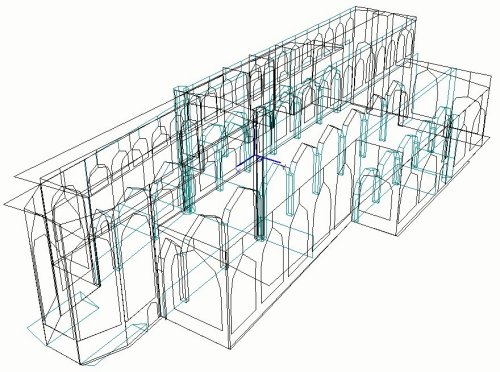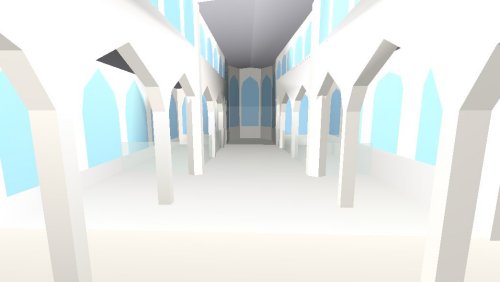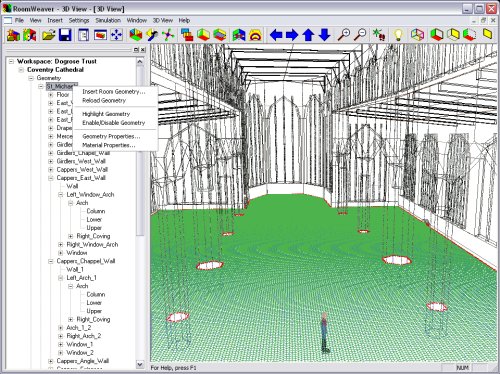Virtual Acoustics
Damian Murphy and Mark Beeson
This webpage serves to present an
introduction and document our work at York in virtual acoustics - the
development of computer based acoustic models for auralization
purposes. It is of course very much linked in with our work on the RoomWeaver
project, but is more focused on the application and presentation of
the result rather than how the result is obtained in the first place.
Links to other resources, practitioners and projects are also
included as a helpful starting point for the interested reader.
There is some prior work in this area. Arup Acoustics are one of the leading advocates of virtual acoustics, auralization and virtual reality applications in their acoustic research, design and consultancy work (but please note that there are others!). For instance find out more about their Soundlab auralization and presentation system here. The CAHRISMA project explored the acoustics of certain Mosques and Byzantine Churches, with a view to a better understanding of heritage sites from the context of acoustic design. It included a significant amount of acoustic modelling work, most (if not all) of which was completed using ODEON geometrical acoustic modelling and auralization software. One of the other leading acoustic modelling applications is CATT-Acoustic, and there are, of course, others including EASE and RAMSETE, the latter of which has significant involvement from Angelo Farina. These are very complete, complex and professional products at appropriately "professional" prices. For an easy and cost-effective introduction to building virtual acoustic models (in 2D only), Voxengo Impulse Modeler is a good and fun starting point. Most of the above applications and feature-limited demos available for download for simple experimentation.
We used ODEON to develop the acoustic model, and architect Peter Howell from the Trust did the hard work of interpreting appropriate plans and various sources to develop a reconstructed and simplified "stripped down" plan and section view that we could use as the basis for our virtual acoustic simulation. The wireframe model produced in ODEON is shown in Fig. 1.

As can be seen it is much simplified (e.g. no spire) from what the original building would have been like, but is sufficient for an acoustic simulation where much of the architectural detail (probably) has minimal influence on the final acoustic result given the size, shape and scale of the overall space. Peter also gave us guidelines on what materials would have been used on the walls and bounding surfaces to help us in our acoustic design work. Fig. 2 shows the internal 3D view.

Two sources were placed - the plainchant choir in the choir of the
church (visible at the far end of Fig. 2) and the narrator positioned
in the centre of the nave (the approximate viewpoint in Fig. 2). The
listener/receiver was placed next to the narrator. A first-order ambsionic
B-format response was generated for the receiver position and
from this a crossed cardioid stereo response was derived. As an
indication as to the acoustic properties of the virtual space ISO3382
T30 [1] was calculated from
the W-channel of the B-format response as shown in Table 1 below.
It is of course impossible to say whether these results are correct given that the building no longer exists in its original form. Also, geometric acoustic techniques are well known to be unreliable in the low frequency (up to about 1kHz) region, but the general result was considered to be appropriate for the space given what was know about its design and how this was actually interpreted for the simulation. One of these impulse response results is available below as both B-format and stereo wav file, together with a short section of plainchant as auralized within the cathedral. What do you think?
We're also hoping to run the same simulation as we did above in RoomWeaver to compare results and see how our work in this area is progressing when compared with a more established benchmark. A screenshot of what St Michael's actually looks like in RoomWeaver is shown in Fig. 3.

dtm, August 2007
Introduction
Despite lots of work relating to impulse response measurement of unique spaces both here at York and further afield, it isn't always possible to obtain measurements of a particular space. Sometimes the space might be inaccessible, or it might not be practical (too much noise or too many people). Alternatively the space might not exist - it might only be an architect's concept design or a composer's ideal and specific performance space, or perhaps the space no longer exists in its original form. In such circumstances a virtual acoustic model must be developed. This has long been the practice in architectural design of acoustically critical spaces where it is possible to develop "walk through auralization" for clients, and these techniques are starting to gain acceptance in other application areas. This page serves to introduce some of these ideas and examples and helps to document our work in the area.There is some prior work in this area. Arup Acoustics are one of the leading advocates of virtual acoustics, auralization and virtual reality applications in their acoustic research, design and consultancy work (but please note that there are others!). For instance find out more about their Soundlab auralization and presentation system here. The CAHRISMA project explored the acoustics of certain Mosques and Byzantine Churches, with a view to a better understanding of heritage sites from the context of acoustic design. It included a significant amount of acoustic modelling work, most (if not all) of which was completed using ODEON geometrical acoustic modelling and auralization software. One of the other leading acoustic modelling applications is CATT-Acoustic, and there are, of course, others including EASE and RAMSETE, the latter of which has significant involvement from Angelo Farina. These are very complete, complex and professional products at appropriately "professional" prices. For an easy and cost-effective introduction to building virtual acoustic models (in 2D only), Voxengo Impulse Modeler is a good and fun starting point. Most of the above applications and feature-limited demos available for download for simple experimentation.
St Michael's Cathedral - 'Old' Coventry Cathedral
York has had a long standing collaboration with The Dogrose Trust - "an innovative charity which works to make all environments accessible to people with visual and other sensory impairments [and] committed to the use of Universal and Inclusive Design and Communication and the Multi-Sensory design" (for instance I contributed chapters to their recent book). In 2004 we were asked to collaborate on a project they were leading on that involved the development of a CD-based audio tour of St Michael's Cathedral, Coventry - or as it is known, 'Old' Coventry Cathedral - that was mostly destroyed in an air-raid on the night of 14th November 1940 during the Second World War. Only the original walls and spire of this medieval building now remain. The intended audience for the CD included those with visual impairments and so it was decided that the quality of the soundtrack was critical and this was to include a reconstruction of what the building would have sounded like at the height of its importance around 1500. The project included the recording of an appropriate narrative and choral plainchant for use as source material.We used ODEON to develop the acoustic model, and architect Peter Howell from the Trust did the hard work of interpreting appropriate plans and various sources to develop a reconstructed and simplified "stripped down" plan and section view that we could use as the basis for our virtual acoustic simulation. The wireframe model produced in ODEON is shown in Fig. 1.

Fig 1. 3D
wireframe view of the ODEON based virtual acoustic model of St
Michael's Cathedral, Coventry.
As can be seen it is much simplified (e.g. no spire) from what the original building would have been like, but is sufficient for an acoustic simulation where much of the architectural detail (probably) has minimal influence on the final acoustic result given the size, shape and scale of the overall space. Peter also gave us guidelines on what materials would have been used on the walls and bounding surfaces to help us in our acoustic design work. Fig. 2 shows the internal 3D view.

Fig 2. 3D
internal OpenGL view of the ODEON based virtual acoustic model of
St Michael's Cathedral, Coventry. Note that this gives a
representation only and is not indicative of what it would have
actually looked like!
|
||||||||||||||||||||||||||||||||||||||||||||||||||||||
It is of course impossible to say whether these results are correct given that the building no longer exists in its original form. Also, geometric acoustic techniques are well known to be unreliable in the low frequency (up to about 1kHz) region, but the general result was considered to be appropriate for the space given what was know about its design and how this was actually interpreted for the simulation. One of these impulse response results is available below as both B-format and stereo wav file, together with a short section of plainchant as auralized within the cathedral. What do you think?
|
||||||
Future Work
Over the next twelve months we are planning to further explore the use of virtual acoustics in heritage applications thanks to an EPSRC funded acoustics collaboration project. We will be working with Dr Peter Rutherford from the University of Nottingham, who was my fellow interviewee on the edition of BBC Radio 4's The Material World that had a feature on or acoustic measurement, modelling and auralization work.We're also hoping to run the same simulation as we did above in RoomWeaver to compare results and see how our work in this area is progressing when compared with a more established benchmark. A screenshot of what St Michael's actually looks like in RoomWeaver is shown in Fig. 3.

Fig 3. 3D
wireframe view of St Michael's Cathedral, Coventry - this time
as defined and viewed in RoomWeaver.
References
[1] ISO3382, Acoustics – Measurement of reverberation time of rooms with reference to other acoustical parameters, ISO, 2nd Ed., 1997.dtm, August 2007